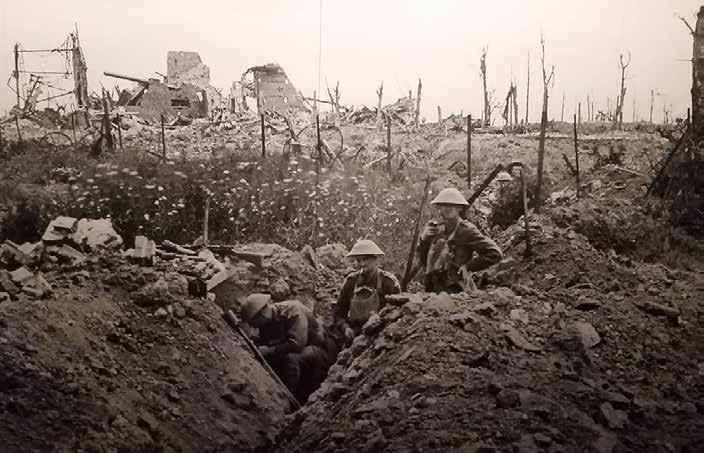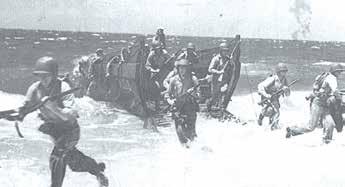
6 minute read
History
Bribie War Heroes
Barry Clark
Advertisement
Bribie Island Historical Society
MORE BRIBIE HISTORY
The Historical Society have monthly public meetings at the RSL Club on the second Wednesday of each month commencing at 6;30pm. with interesting guest speakers on a wide range of topics. You can see many more photos and articles on our Blog Site at http:// bribieislandhistory.blogspot. com or contact us on bribiehistoricalsociety@gmail. com Bribie Island Historical Society received a grant from Queensland Anzac Centenary Grants program to identify all enlistee’s inWW1 and WW2 who were born or lived on Bribie Island or Pumicestone Passage when they enlisted. From an original number of three WW1 enlistments, our research has now identified 18 from this area who answered the call. Considering that the population of Bribie Island in 1915 was about 40 and assume the same “up the passage” 18 is quite significant. So who were these men?
Three of them paid the ultimate sacrifice…
William GOSLING, c1898-1918, the youngest enlistee age 18y10m and a farmer when he enlisted 26 Bn 11 Sep1915. NOK living at Bribie Light keeper’s residence, North Bribie Island. He was KIA in France on 8 Aug 1918 and is buried VillersBretonneux Military Cemetery, Villers-Bretonneux, Picardie, France. Alexander Thomas DAVIS 1892 – 1919, a fisherman when he joined 42Bn on 1 Oct1916 and served in France until seriously wounded 9 Jun 1918. He was evacuated to England and then Australia where he died of wounds on 5th May 1919. Arthur William STORR, 1899 – 1917, a surveyor's assistant when he joined 9Battalion (Bn) 14 Sep 1915, Tragically killed in action (KIA) France 26 Mar 1917 and remembered on the VillersBretonneux Memorial, Picardie, France. He gave his next of kin (NOK) address as “Bribie View, via Caboolture”. Arthur William STORR had two brothers also enlisted. Harold Francis STORR, b1893. He was a plumber when he joined 15 Bn on16 Sep 1914. He gave his NOK address as “Donnybrook, via Caboolture, N.C.Line”. 15Bn landed Gallipoli 25 Apr 1915. He was wounded on 7 May 1915 treated in hospital at Mustapha and returned to his unit on 17 Oct1915. He remained with the Bn when it went to France and returned to Australia in Jul1919. Charles Allan STORR, b1896. He was a butter maker when he also joined 9 Bn 16Sep 1915. He returned home on 17 Jul 1919. He gave his NOK address Caboolture as “Bribie View, via Caboolture, N.C.Line”. Alan LAYTON, b1886 was the eldest enlistee at 37yo. He joined 4 Pioneer Bn on 29Nov 1916 and served in France. He was a storekeeper, married with family living on Bribie in 1916.
Reginald Joseph CAMPBELL, 1896 – 1976
Walter Henry MILLS, 1886 – 1961
served in Australia. Reg was born and died on Bribie Is. Reg was also an oysterman, a fisherman, and eventually a storekeeper. His last address was 7 South Esplanade Bongaree, Bribie Is. Two brothers, both fishermen who enlisted were Edward Henry FREEMAN, 1896 –1957, who enlisted 11 Bn 7 Sep 1916 and William FREEMAN, b1890, who enlisted 3 Machine Gun Bn 17 Sep 1916. They both served in France and returned in 1919. William also served in WW2.
Another family had three sons enlist. Walter Henry MILLS, 1886 – 1961, was a carpenter when he enlisted 25 Bn 20 Jan 1915. He was born Woorim on 23 Sep 1886 and is the earliest known Bribie Island birth. John Robert MILLS, b1893, enlisted into 2Remount Unit 5 Nov 1915. He served in Egypt until repatriated with deafness in Apr 1916. He and his third brother Thomas James MILLS, b1891joined 15 Bn 19 Nov 1914. He also served in Egypt and returned to Australia suffering rheumatism on 29 July 1915. Both were born at Toorbul. Maurice Alexander BISHOP, 1892 – 1973, enlisted 11 Depot Bn 26 Apr 1916, did not serve overseas and was discharged 18 May 1916. He was born at Toorbul. Walter Herbert BONNEY 1896 – 1976. Carpenter when he joined 26 Bn 18 Oct 1915 served in France and transferred to 2 Division Signal Company in Jul 1918. He was born at Toorbul also. Bertie DUX, 1896-1973. He was a railway porter when he joined 11 Bn 15 Jun 1916 and served in France where he was wounded. He was born at Toorbul. In Jul 1919 he was granted leave to work with a coach building firm in London for a few weeks to gain experience before coming home. George Leslie GOLLAGHER, 1894 – 1964. A Bullock driver and was living Toorbul when he enlisted 2 Nov 1916. He joined 31 Bn and served in France. George Ernest JACQUES, 1890 – 1962. He gave his occupation as machinist was born at Coochin. He joined 49 Bn 15 May 1916. In the early hours of ANZAC Day 1918 in France the 49th participated in the now legendary attack to dislodge the enemy from Villers-Bretonneux. Thomas Martin TRIPCONY,b c1890, He was a farmer and joined 49 Bn 22 Nov 1915. He was then living at Cowie on Pumicestone Passage. He was wounded in Oct 1917 which resulted in him being returned to Australia in 1918.
Bribie War History

In 1939, World War 2 started in Europe. As War spread, America joined, and Brisbane became the garrison town for American troops heading to War in the Pacific. As Japan advanced south through Asia, invasion of Australia seemed inevitable. The Brisbane Line of defence drawn across Australia, and strategic defence Forts with Guns and Submarine detection systems were built on north and south Bribie Island. Most residents were evacuated, soldiers occupied key buildings, and a large military training camp for American and Australian troops operated at Sandstone Point ……..where the Tavern stands today. The Army constructed a basic road from Caboolture to the Training Camp at Sandstone Point, and a Barge service carried troops and military equipment across the Passage to the island. The barge ferry service was taken over by civilian residents of Bribie from 1947, and thus began a new era of motor vehicle transport. As motor vehicles became more popular, within a few years the popular steamship Koopa, that had carried millions to Bribie for more than 40 years, ended in 1953. After the War when building materials were scarce several old buildings were brought to Bribie and re-erected for various purposes. Savige’s Fish shop was once a military Hospital in Brisbane before it was brought to Bribie. With progress and development, the population increased, and by the early 1960s, there were about 700 residents on Bribie. Eventually, a Bridge was constructed in 1963 and in the expected boost to visitor numbers several new commercial businesses started up. A large recreation hall was built in Cotterill Avenue which operated as a Skating Rink and Dance Hall, and eventually became a Cinema. Today it is the Baptist Church. Movies were the main focus of public entertainment for many years before TV was available. Another business venture at the time of the Bridge was a mini “Sea World” sea water aquarium constructed at Red Beach. Created by people who developed new techniques to display seawater fish in large concrete and glass tanks constructed in the bush at Red Beach. It was never a business success but the remains of some of these aquarium tanks can still be seen in the bush at Red Beach. With the Bridge came many more cars, no longer having to come by Barge from the mainland, and several Petrol stations were opened on Bribie. Where “Scoopy’s” Cafe stands today was once a Petrol station.










